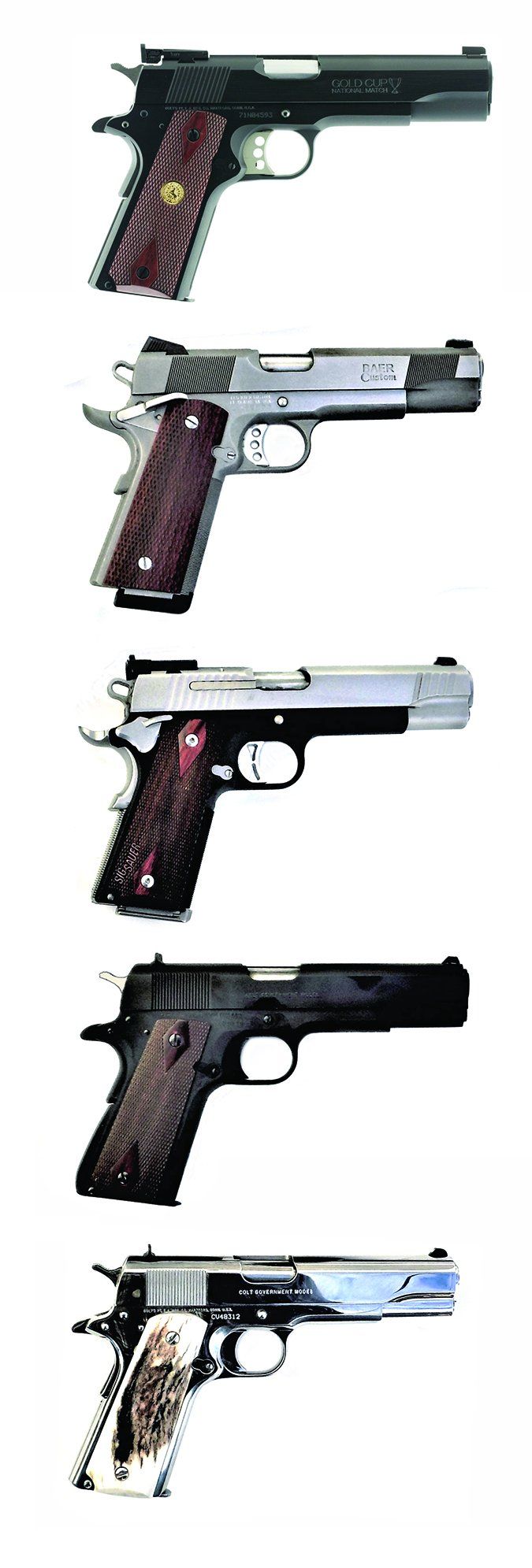
The 1911 is a legendary handgun, and it has been offered in many variations since its introduction 108 years ago. During the time after World War I, there were attempts to make the 1911 into a more accurate handgun, primarily for use at Camp Perry. The first National Match handguns were modified by Army gunsmiths for the task. Colt made the pistol commercially available as the National Match during the 1930s. The first guns featured high-profile fixed sights and were considerably tightened over the fit of the Government Model. Colt offered the Gold Cup pistol as a target pistol set up for light loads. Today, we like to have a 1911 with a lighter trigger action than the GI gun and with superior sights, but do we really need an expensive handgun or a target gun for overall utility? For personal defense and most forms of competition, the handguns reviewed will do a good job. They are useful for personal defense, some forms of competition, and for hunting varmints, and even medium-size game, at moderate range. The trick is, how much do you have to pay for this performance?
45 ACP Range Data
| Black Hills Ammunition 200-gr. Lead SWC | Les Baer Concept VI | SIG Sauer Match Elite | Colt Government Model | Colt Series 70 | Colt Gold Cup National Match |
| Average velocity | 890 fps | 874 fps | 847 fps | 880 fps | 864 fps |
| Muzzle energy | 351 ft.-lbs. | 339 ft.-lbs. | 318 ft.-lbs. | 343 ft.-lbs. | 331 ft.-lbs. |
| Smallest group | 1.9 in. | 2 in. | 2.6 in. | 1.8 in. | 1.5 in. |
| Average group | 2.1 in. | 2.3 in. | 2.9 in. | 2.2 in. | 1.7 in. |
| Remington Golden Saber 230-gr. HP | |||||
| Average velocity | 870 fps | 862 fps | 860 fps | 867 fps | 851 fps |
| Muzzle energy | 386 ft.-lbs. | 379 ft.-lbs. | 377 ft.-lbs. | 383 ft.-lbs. | 369 ft.-lbs. |
| Smallest group | 2 in. | 2.6 in. | 2.8 in. | 2.2 in. | 1.7 in. |
| Average group | 2.2 in. | 2.8 in. | 3.1 in. | 2.5 in. | 1.9 in. |
| Hornady 200-gr. XTP | |||||
| Average velocity | 907 fps | 922 fps | 880 fps | 892 fps | 901 fps |
| Muzzle energy | 365 ft.-lbs. | 377 ft.-lbs. | 343 ft.-lbs. | 353 ft.-lbs. | 360 ft.-lbs. |
| Smallest group | 1.5 in. | 1.8 in. | 2.5 in. | 1.8 in. | 1.2 in. |
| Average group | 1.8 in. | 1.9 in. | 2.8 in. | 2.3 in. | 1.4 in. |
| We fired five-shot groups at 25 yards using a Bullshooters pistol rest. We collected chronograph data with an RCBS Ammomaster set 15 feet from muzzle, temperature 56 degrees. Ammo sources: Black Hills Ammunition 200-grain Semi-Wadcutter ($14.57/20 rounds from VenturaMunitions.com); Hornady 200-grain XTP ($17.50/20 rounds from LuckyGunner.com); and Remington 230-grain Golden Saber ($26/25 from MidwayUSA.com). | |||||
Les Baer Concept VI 45 ACP, $2290
GUN TESTS GRADE: A-
The Les Baer Concept VI is a carry and combat pistol and features fixed sights versus other handguns offered by Les Baer that feature adjustable sights. The piece is very accurate. Stainless construction offers considerable resistance to the elements. The pistol did not require the break-in period that other handguns sometimes do. It wasn’t faultless; we dinged it for a sharp edge on the safety. This is a great handgun if you can handle the price.
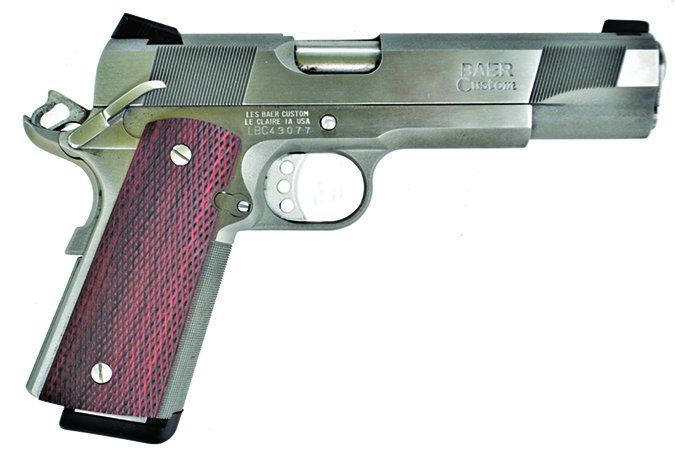
| ACTION | Single action only; locked breech, Baer hammer |
| OVERALL LENGTH | 8.7 in. |
| OVERALL HEIGHT | 5.4 in. |
| OVERALL WIDTH | 1.3 in. |
| WEIGHT UNLOADED | 39 oz. |
| WEIGHT LOADED | 44 oz. |
| BARREL LENGTH | 5.0 in. long, Baer NM stainless steel; Baer stainless steel throated |
| BARREL | Steel |
| MAGAZINE | (2) 8-round |
| SLIDE | Stainless steel |
| SLIDE RETRACTION EFFORT | 18.75 lbs. |
| FRAME | Baer NM, stainless steel |
| FRAME FRONT STRAP HEIGHT | 2.8 in. |
| FRAME BACK STRAP HEIGHT | 3 in. |
| GRIPS | Checkered wood |
| GRIP THICKNESS (max) | 1.3 in. |
| GRIP CIRCUMFERENCE (max) | 5.5 in. |
| FRONT SIGHT | Post, dovetailed base |
| REAR SIGHT | Notch, dovetailed base |
| TRIGGER PULL WEIGHT | 5 lbs. |
| TRIGGER SPAN | 2.6 in. |
| SAFETY | Beavertail grip safety w/pad; Baer extended ambi safety |
| WARRANTY | None written |
| WEBSITE | LesBaer.com |
| TELEPHONE | (563) 289-2126 |
| MADE IN | LeClaire, IA |
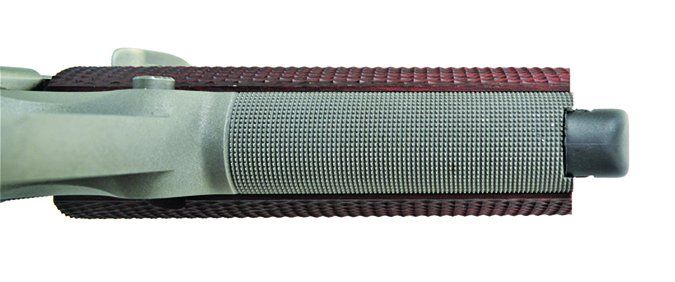
This was the build price at LesBaer.com. Les Baer’s handguns have a reputation for handfitting and tight fit. This handgun certainly exhibited these close tolerances. A concern with the pistol was a break-in period. At one time, a break-in period with new 1911 handguns was SOP. Baer, in fact, recommends 300 rounds of full-power ammunition as a break in. As one rater noted, he has run his 1994 Corvette on the recommended lubricants, not cheaper oil, and the engine doesn’t smoke or use oil at 289,000 miles, so paying attention to the manufacturer’s recommendations may be important. Les Baer tells us the pistols are built, not assembled, and the pistol shows signs of a great deal of care in manufacture. When tolerances are tight, there is less slop, and this means less eccentric wear in the long run. This also means greater accuracy. We were looking for accuracy, but we also wanted reliability. The Concept VI is a personal-defense stainless-steel handgun similar to other Les Baer handguns, but with fixed sights rather than adjustable sights. The fit and finish are excellent, with all parts mating without any slop. The slide features a round top and Novak-type fixed sights. These sights afforded an excellent sight picture. Of the three fixed-sight guns, these sights were the best, beating out the Colt Series 70 and Colt Bright Stainless guns. Sight picture is as good as the adjustable-sight guns, we felt, but not adjustable for many bullet weights. There were no white outlines in these sights. The fit of the barrel bushing to the slide is tight, but with the aid of a bushing wrench, we were able to disassemble the pistol without difficulty. After the initial firing stage, most raters were able to disassemble the pistol by hand. The slide features forward cocking serrations. The cuts are nicely done. The barrel, Baer tells us, features precision cut rifling.
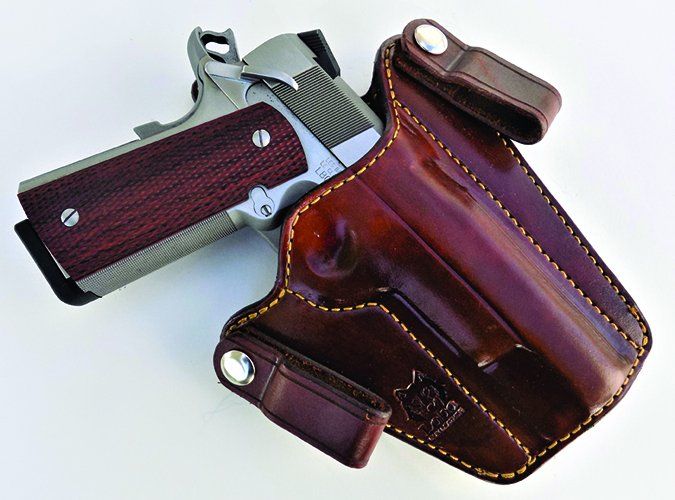
The Concept VI features a skeletonized hammer. The part is all steel, no MIM in this pistol. The slide lock safety is an ambidextrous design. We like this and feel that a tactical/personal defense handgun profits from this type of safety. The lever on the right side of the frame, for left hand use, isn’t as large as the left hand side safety. Indent is tight and sharp. In this day of mushy indent and poor fitting in economy grade handguns, the Les Baer exhibits an ideal engagement.
Ideally, the grip safety should funnel the shooter’s hand into the frame, lower the bore axis, cushion recoil, and protect the shooter from sharp edges. It must also release its hold on the trigger about halfway into its travel. The Les Baer does all this. Shooters who adopt the thumbs-forward grip style sometimes allow the palm to form a cup and raise the hand from the grip safety. The Les Baer design is by far the best of the test and eliminates this problem. Trigger compression is tight with minimal take up. The trigger is aluminum with a flat face. According to the Lyman electronic trigger pull gauge, trigger compression is exactly 5.0 pounds and consistent with every trigger press. The front strap is checkered at 30 lines per inch. This makes for excellent adhesion when firing the pistol. The grips complement this checkering. They appear to be cocobolo. They are not raspy, but are solid in the hand. The magazine well is slightly beveled for rapid magazine changes. The pistol is supplied with two magazines. Interestingly, the Concept VI was delivered in a simple cardboard box.
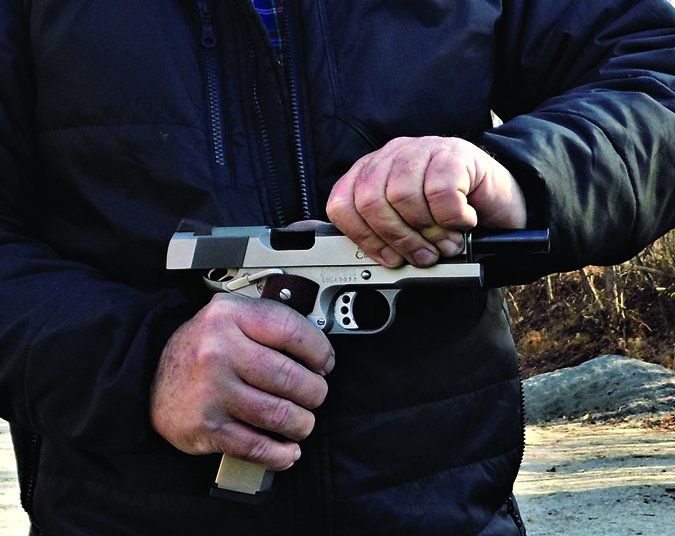
We made certain the pistols were well lubricated on the bearing surfaces, cocking block, barrel hood, and barrel bushing before beginning an extensive firing test, not accomplished in a short period of time. We elected to fire each handgun with 300 cartridges in combat drills and offhand fire before firing for accuracy off the bench rest. Three hundred cartridges fired in a steel-frame 45 can be punishing to the wrists; it sneaks up on you rather than offering sharp pain at the beginning as when firing a magnum, but we proceeded in relays. On the firing range we began with 200 handloads and 100 factory rounds. We supplemented the original magazines with a stack of Wilson Combat 8-round magazines and a mix of the magazines supplied with the pistols, primarily six Colts, two Les Baer, and two SIG Sauer magazines. The handloads consisted of the 230-grain Oregon Trail bullet over enough WW231 for 845 fps average, a hardball equivalent load. Another consisted of a lighter load, an Oregon Trail 200-grain SWC and enough Titegroup for 890 fps. One hundred rounds of Remington 230-grain UMC ($19.79/50 from MidwayUSA.com) were fired in the handguns as well.
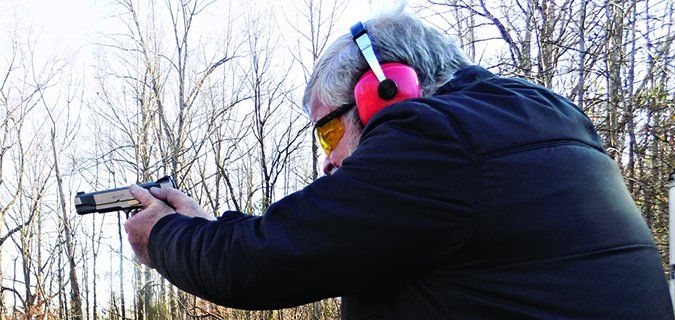
We began with the 230-grain handload as it mimics 230-grain ball. We fired at man sized targets at 7, 10, and 15 yards and also fired at steel plates from 15 to 50 yards. The initial rounds were fired as quickly as the raters could fire and reload. The Les Baer did not suffer any failures to feed, chamber, fire or eject. There were no break-in malfunctions. Practical accuracy and control were excellent. The 200-grain SWC loads felt like light target loads. The sights are regulated for 230-grain loads and a 6 o’clock hold at 25 yards. A dead-on hold was useful for knocking down plates at 50 yards. The experience was pleasant for all raters.
After the pistol was thoroughly cleaned, no wear was detected. Next, we moved to the bench and firing for accuracy. We used a mix of service and personal-defense ammunition and another proven for accuracy. The three loads tested were the Black Hills Ammunition 200-grain semi-wadcutter, Hornady 200-grain XTPs, and Remington 230-grain Golden Sabers. The Les Baer comes with an accuracy guarantee of 3 inches at 50 yards. Only one load, the Hornady XTP, met the 1.5-inch 25-yard equivalent. The others were 2.0 inches for the Remington and 1.9 inches for the Black Hills load.
The only drawback encountered during firing was that some of the raters suffered a slight pinch on the thumb from the safety when drawing and getting into action by pressing the safety down for fire, but not during firing. A little polish could cure that. There were no failures to feed, chamber, fire or eject, and the Les Baer exhibited the best combat performance of any of the five guns tested. The Les Baer and the Colt Gold Cup traded off for top accuracy, with the Colt equaling the Concept VI in practical terms. The Colt’s best group was smaller.
Our Team Said: As a personal-defense pistol or a go-anywhere do-anything emergency gun, the Les Baer Concept VI is our pick if price is no object. We rated it down a half a grade on the sharp edge that annoyed some raters.
SIG Sauer Traditional Match Elite 1911T-45-TME 45 ACP, $1050
GUN TESTS GRADE: D
This pistol needed a little help out of the box. That said, the SIG is accurate and handles well. Adjustable sights and a checkered front strap are good features. If you’re willing to do some light gunsmithing, mentally move the grade up to B.
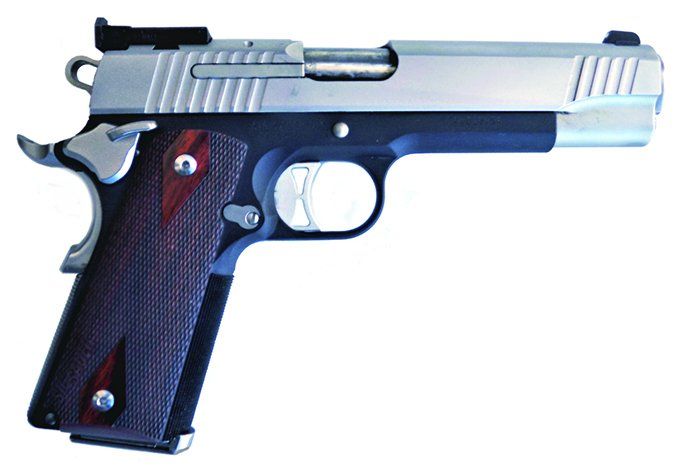
| ACTION | Single action only, locked breech, Cmdr. hammer |
| OVERALL LENGTH | 8.7 in. |
| OVERALL HEIGHT | 5.4 in. |
| OVERALL WIDTH | 1.3 in. |
| WEIGHT UNLOADED | 39 oz. |
| WEIGHT LOADED | 44 oz. |
| BARREL LENGTH | 5 in. |
| BARREL | Steel |
| MAGAZINE | (2) 8-round |
| SLIDE | Steel |
| SLIDE RETRACTION EFFORT | 17.9 lbs. |
| FRAME | Steel |
| FRAME FRONT STRAP HEIGHT | 2.8 in. |
| FRAME BACK STRAP HEIGHT | 3 in. |
| GRIPS | Checkered wood |
| GRIP THICKNESS (max) | 1.3 in. |
| GRIP CIRCUMFERENCE (max) | 5.5 in. |
| FRONT SIGHT | Post |
| REAR SIGHT | Adjustable |
| TRIGGER PULL WEIGHT | 6.1 lbs. |
| TRIGGER SPAN | 2.6 in. |
| WARRANTY | 5 year |
| WEBSITE | SIGSauer.com |
| TELEPHONE | (603) 610-3000 |
We have seen this pistol on sale at various times for less, particularly in 9mm, but this is what was available in late 2018 at TombstoneTactical.com. It’s now out of stock at that retailer. As good-quality 1911 handguns go, this isn’t terribly expensive, but to most of the raters, one thousand dollars is a lot of money. What you get is a pistol that differs in some respects from John Moses Browning’s original 1911, but then most all modern 1911 handguns do. When SIG Sauer introduced its 1911 handguns some time ago, the slides were designed to bear a resemblance to the P-series pistols, such as the SIG P220. The look is different, and while the Granite Series were good guns, they did not fit 1911 holsters. The TME here is a standard 1911 slide.
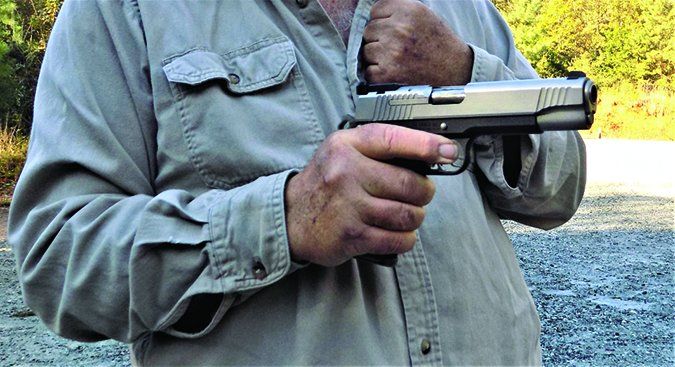
The pistol is attractive, with a stainless-steel slide and blued frame. The grips are cocobolo, perhaps the best looking of the test. The checkering is nicely done, and the SIG Sauer monogram on the grips is tasteful. The pistol features forward cocking serrations. There is no full-length guide rod, which some prefer. The front post offers a good aiming point. The rear sight is adjustable. The edges of the rear sight leaf are beveled. This results in less covering of the target and faster acquisition. Otherwise, the SIG sight is similar to modern Bomar-type sights. The SIG features an external extractor, unlike all of the other handguns, which feature the original tool-steel-type extractor. SIG extractors have proven reliable and long lived in action, but so have properly fitted tool-steel internal extractors. The SIG uses a Series 80-type firing-pin block. So do the Colt National Match and Bright Stainless units. The Les Baer and the Series 70 have extra-strength firing-pin springs.
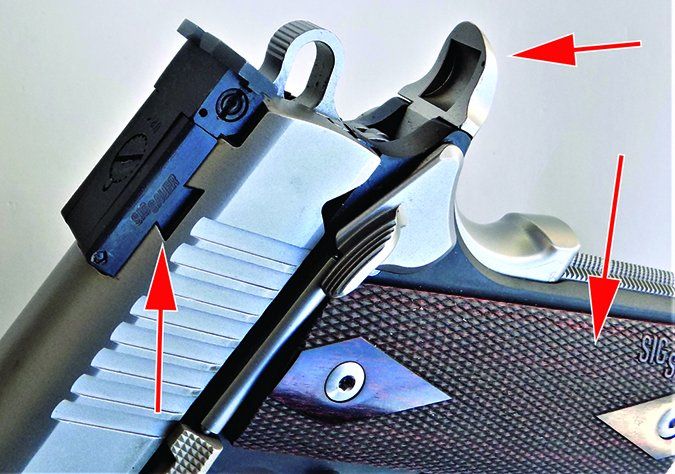
The ambidextrous safety levers of the SIG are the smallest tested, but work well in practice. The grip safety is a modern beavertail safety that works as designed. The mainspring housing features a lanyard attachment, and the grips are beveled at the base. The magazine well is funneled to aid in changing magazines. The front strap is checkered at 25 lines per inch. While it isn’t as nice as the Les Baer’s 30-lpi rate, the checkering is well done and aided in our range work. The trigger is aluminum with a grooved face. Trigger compression is 6.1 pounds. It felt lighter, but isn’t when measured. The pistol is supplied in a locking hard-plastic case and two magazines.

We began the firing test with a lubricated handgun and the same magazines and ammunition used with the other handguns. We began to experience problems. The pistol would fire six to seven rounds, and then the slide would fail to go fully into battery. This persisted with every loading and with every magazine. The senior rater, also a qualified gunsmith and 1911 fan, deemed it a function problem not related to the magazines or ammunition. We put the pistol aside and came back to it later.
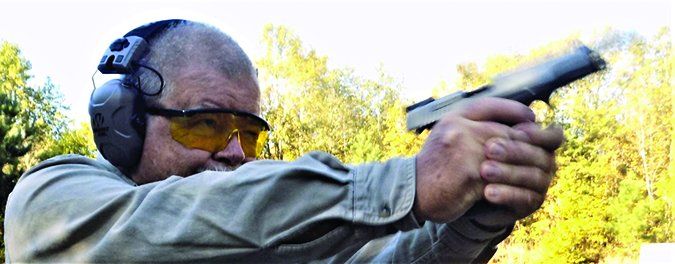
When we did, we cleaned and disassembled the handgun. The recoil spring caught our attention with its different configuration. It is a flat wire type. We changed this out with a spring borrowed from one of the Colts. The SIG ran through several magazines. We then permanently replaced the SIG spring with a Wilson Combat standard-weight recoil spring. The test was begun anew with the SIG, and it ran fine and finished the combat evaluation without a single drawback. We are all for innovation, but sometimes you should not mess with success. To recap: The pistol short-cycled with the factory-supplied spring with all loads, but the problem was cured with the addition of a Wilson Combat 16-pound recoil spring ($5.56 from WilsonCombat.com).
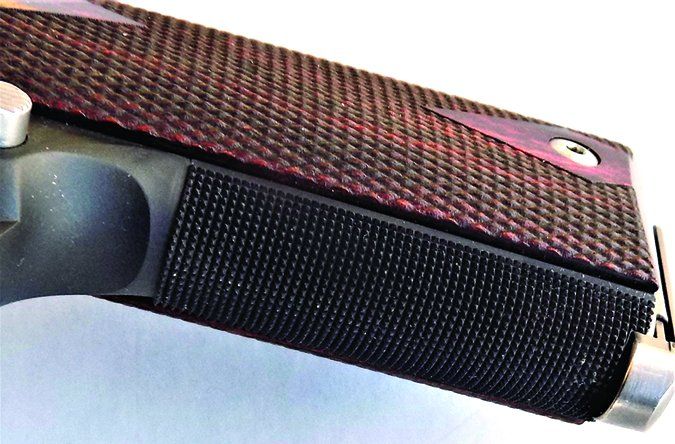
During the combat-firing evaluation with the new spring, the pistol never failed to feed, chamber, fire or eject. Results were good to excellent from 7 to 50 yards. The 50-yard plates were a slight challenge that perhaps could have been aided by a lighter trigger compression. The pistol proved useful in all drills. Only the Les Baer gave a better showing. The SIG was very close as these things are rated in combat shooting, which is less exact than firing for absolute accuracy. Firing off the bench, the most accurate load was the Hornady 200-grain XTP at a solid 1.75 inches. The Black Hills Ammunition 200-grain SWC averaged 2.0 inches, and the Remington 230 grain load, 2.6 inches.
Our Team Said: The SIG Sauer 1911 was reliable after the initial short cycles. The pistol is reliable and offers excellent combat shooting facility. It was the third-most-accurate handgun tested. We rated it down a full grade for the recoil-spring problem. At the same time, we agreed that as an all-round defensive handgun that could double as a hunting or competition handgun. If you’re willing to buy and replace one spring.
Colt Bright Stainless Government Model O1070BSTS 45 ACP, $1550
GUN TESTS GRADE: B-
This is a handgun with flawless fit, finish, and build quality. The polished-stainless frame, slide, and parts are eye pleasing. The sights are good, but not as good as the other handguns. The slippery grip isn’t easily addressed.
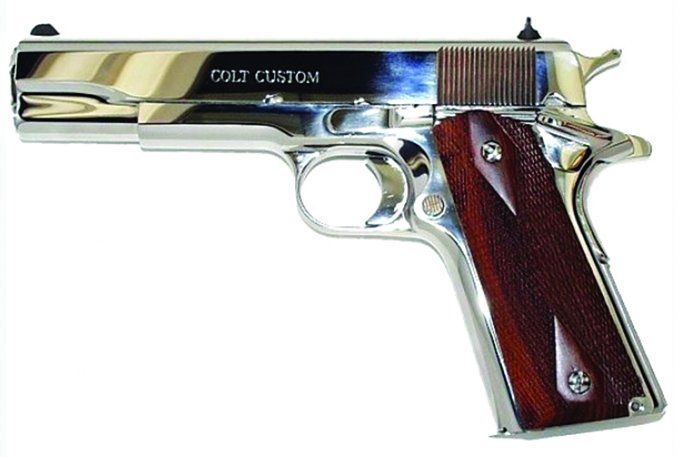
| ACTION | Single action only; locked breech, spur hammer |
| OVERALL LENGTH | 8.7 in. |
| OVERALL HEIGHT | 5.4 in. |
| OVERALL WIDTH | 1.3 in. |
| WEIGHT UNLOADED | 37 oz. |
| WEIGHT LOADED | 42 oz. |
| BARREL LENGTH | 5 in. |
| BARREL | Stainless steel |
| MAGAZINE | (2) 8-round |
| SLIDE | Bright stainless steel |
| SLIDE RETRACTION EFFORT | 15 lbs. |
| FRAME | Bright stainless steel, beveled magazine well |
| FRAME FRONT STRAP HEIGHT | 2.8 in. |
| FRAME BACK STRAP HEIGHT | 3 in. |
| GRIPS | Double diamond rosewood, checkered |
| GRIP THICKNESS (max) | 1.3 in. |
| GRIP CIRCUMFERENCE (max) | 5.5 in. |
| FRONT SIGHT | Fixed post, white dot |
| REAR SIGHT | Fixed notch, two white dots |
| TRIGGER PULL WEIGHT | 6.2 lbs. |
| TRIGGER SPAN | 2.6 in., stainless steel |
| SAFETIES | Thumb, Grip, Firing Pin |
| WARRANTY | Lifetime |
| WEBSITE | Colt.com |
| TELEPHONE | (800) 962-COLT |
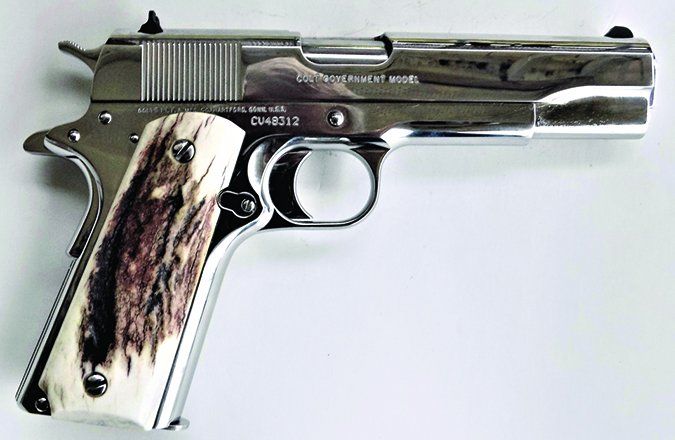
This is a unique pistol that may end up being difficult to find, so we include its UPC number: 098289111579. We located a number of 38 Super pistols for sale that appeared identical, but few 45s. The pistol is stamped “Government Model” on one side and “Colt Custom” on the other. The pistol appears to be nickel finished, but it is actually a high-polish stainless, something called Ultra Polish in some ads. The pistol is eye catching, that is for certain. It is supplied in a hard locking case with two stainless magazines. This is the personal gun of one of the raters, and we borrowed it for this shoot out. The pistol has the general outline of the 1991A1, but there are important differences. This stainless-steel handgun has no plastic parts. The controls are standard Colt. The beavertail safety is flat, but it is an improved type over early 1911s, and the mainspring housing is flat. The trigger has a curve in it, but it is a long trigger. The sights are improved compared to the original GI type. They are identical to the ones fitted to the Series 70 gun. They feature three dots for aiming. The pistol has the appearance of an early Colt in some ways, but the ejection port is the modern scalloped type introduced with the Series 80 handguns. The fit and finish of this handgun is flawless in every way. There were no tool marks inside or out, and the Colt is a great piece as a barbecue gun. It is supplied with a set of checkered grips identical to the Colt Series 70, but the owner had fitted a set of stag MD Grips (MDGrips.com). The raters were neutral on this addition, they look good but do not affect handling.
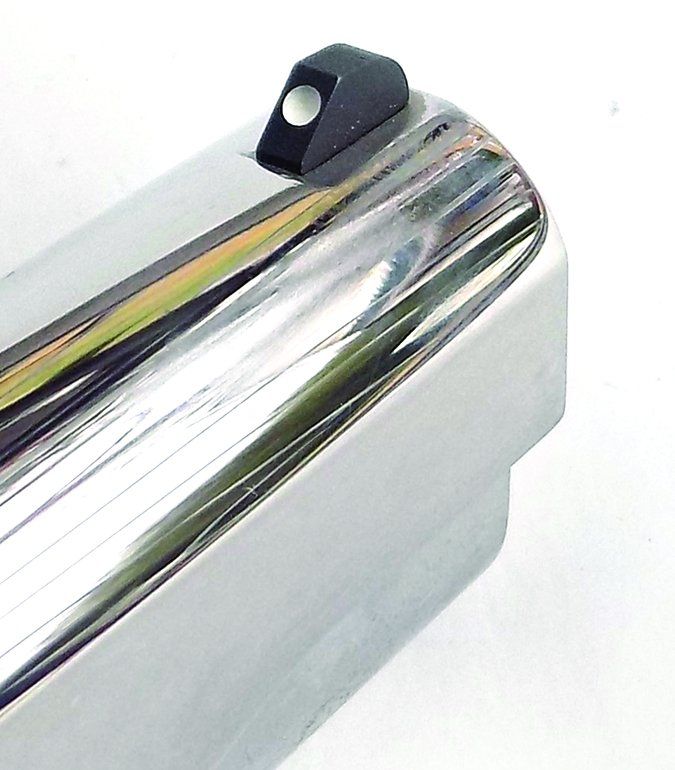
We expected the long trigger to offer good control. As we examined the pistol we tested trigger compression. The pistol’s trigger is heavy at 6.2 pounds, but not as smooth as the SIG’s also heavy trigger. The pistol was dry fired for acclimation, and all commented that this is a lot of money for a pistol with a staked on front sight. We would have preferred a dovetail front sight. Surely Colt understands most of us will fire and use this handgun. A real problem that was not as apparent with the Colt Series 70 was that the front strap is slippery. The whole polished stainless surface felt slippery to the hand. When we loaded the magazines and began firing, this was a drawback in controlling the pistol.
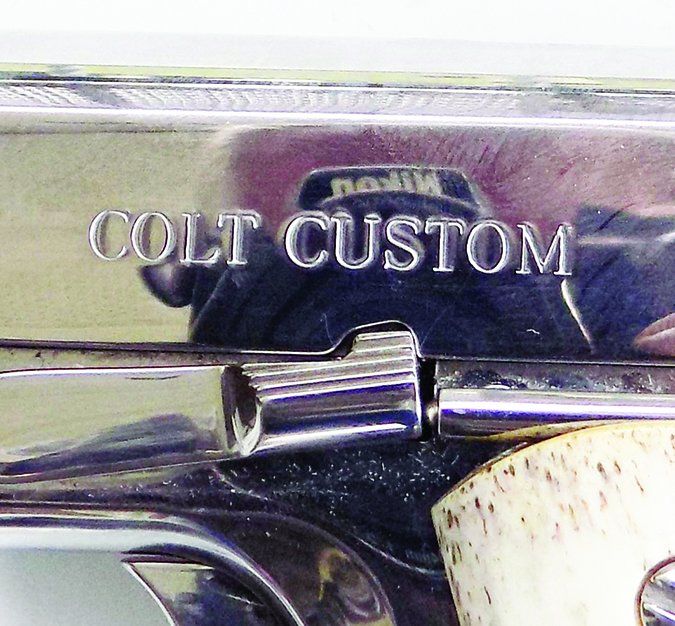
Still, we did well drawing and firing for results at close range. The pistol draws quickly and offers real speed to a first-shot hit. The problem is that the slippery front strap really slips in the hand after four or five rounds. The MD grips are cupped in the center and have a rough bark, but that isn’t the problem compared to the original checkered grips. The front strap is slippery. We considered fitting the pistol with a set of Pachmayr Signature or Hogue Monogrips, but that would have defeated the purpose of paying more than fifteen hundred dollars for a sensational looking carry gun. So we left it as it. Unlike the SIG, it functioned and did not demand a new part. It simply did not handle as well as we would have liked.
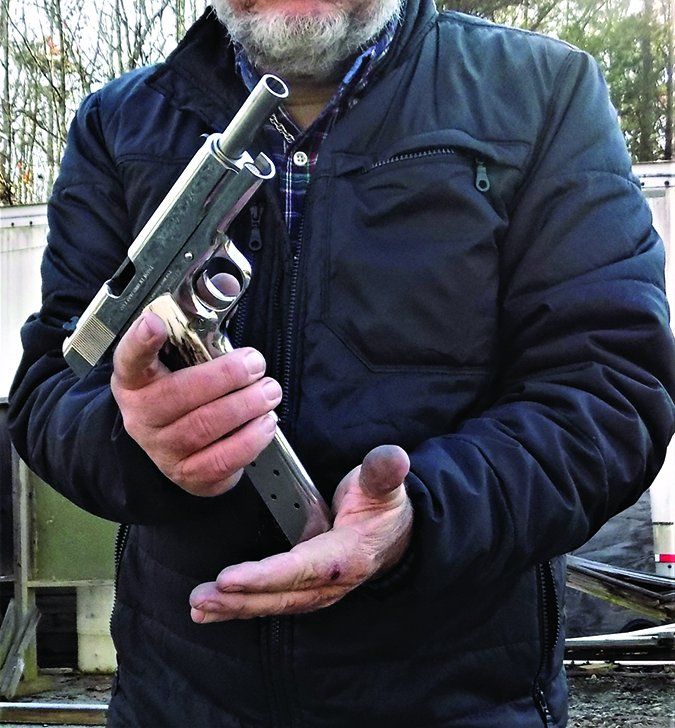
The highly polished Colt was the least desirable pistol in the combat trials. There were no problems with reliability; the pistol simply was slippery due to the front strap. Firing at steel at 50 yards, the pistol suffered compared to the others as well, largely due to the heavy trigger. In firing for accuracy from a benchrest, the High Polish Colt was the least accurate 1911 tested, although it wasn’t a dog by any means. The pistol did not slip as badly when stabilized in the Bullshooter’s rest. The Remington 230-grain JHP had a best group of 2.8 inches at 25 yards, with average groups of 3.2 inches.
Our Team Said: This nice-looking stainless-steel Colt is reliable and accurate enough for personal defense. It never failed. It features the Series 80 firing pin block for those who prefer it. It needs a different set of grips to be all it can be. We rated it down on several points including a heavy trigger, slippery front strap, and only fair accuracy. It isn’t worth the money as a combat gun, in our opinion.
Colt Series 70 01970A1CS 45 ACP, $865
GUN TESTS GRADE: A (Best Buy)
This handgun is the least expensive tested, but it could be the best carry gun. The fixed sights are adequate for most purposes, although they are a strain to use well on the 50-yard plates. The pistol is reliable, handles quickly, and offers fast hits. It is more in keeping with the idea of a fighting gun popularized by Colonel Cooper: Such a gun needs good sights, a good trigger and a good safety — and little else — to make it a good combat pistol.
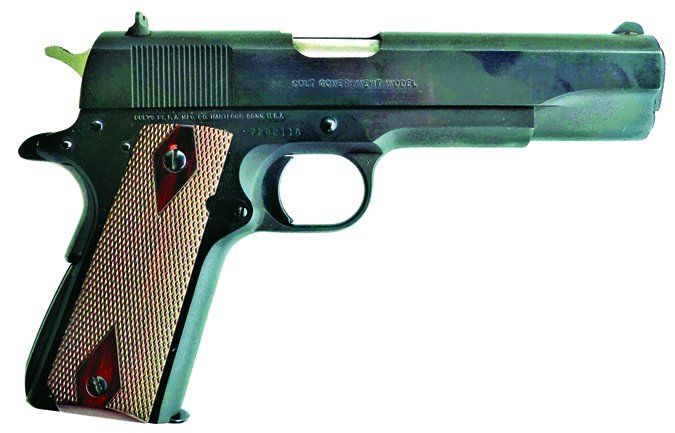
| ACTION | Single action only; locked breech, spur hammer |
| OVERALL LENGTH | 8.7 in. |
| OVERALL HEIGHT | 5.4 in. |
| OVERALL WIDTH | 1.3 in. |
| WEIGHT UNLOADED | 37 oz. |
| WEIGHT LOADED | 42 oz. |
| BARREL LENGTH | 5 in. |
| BARREL | Steel |
| MAGAZINE | (2) 8-round |
| SLIDE | Steel |
| SLIDE RETRACTION EFFORT | 17 lbs. |
| FRAME | Steel |
| FRAME FRONT STRAP HEIGHT | 2.8 in. |
| FRAME BACK STRAP HEIGHT | 3 in. |
| GRIPS | Checkered wood |
| GRIP THICKNESS (max) | 1.3 in. |
| GRIP CIRCUMFERENCE (max) | 5.5 in. |
| SIGHTS | Fixed |
| TRIGGER PULL WEIGHT | 5.5 lbs. |
| TRIGGER SPAN | 2.5 in. |
| WARRANTY | Lifetime |
| WEBSITE | Colt.com |
| TELEPHONE | (800) 962-COLT |
| MADE IN | USA |
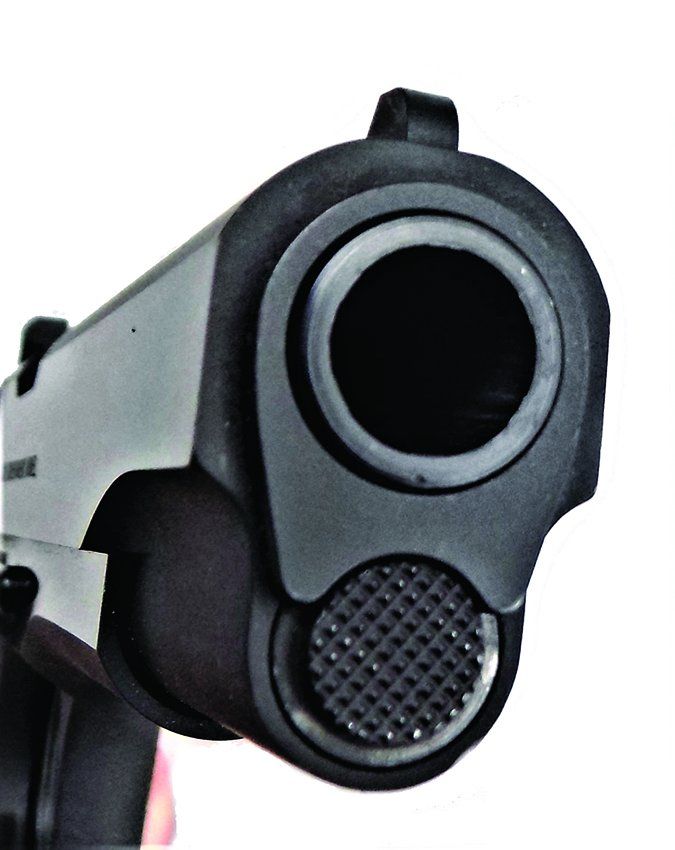
This was a recent price from BudsGunShop.com. The original 1911 featured what is referred to as a flat mainspring housing and long trigger. The 1911A1 answered complaints about handling and was changed to the arched housing and short trigger. Generally, these make for faster handling in a combat situation, while the long trigger and flat housing make for a better choice on a target-style pistol. Today, the flat housing is used because a beavertail grip safety mates with the flat housing better. Modern handguns are often manufactured with the long trigger and flat housing, but have 1911A1 improvements, including finger slots in the frame and a shorter hammer spur. The short trigger is about a quarter inch shorter than the long-style trigger. The shorter trigger is more friendly to shooters with small hands and short fingers. So is the arched housing.
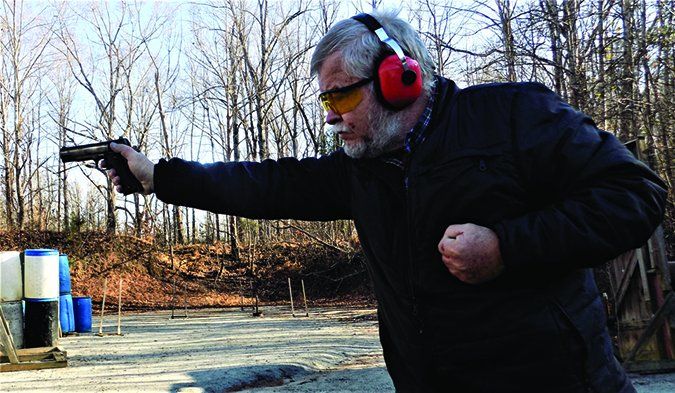
The original Series 70 was introduced as an improvement over commercial Colts manufactured up to 1970. All Colts were given a general tightening up. The Series 70 was given the collet bushing, a barrel bushing with fingers that helped keep the bushing and barrel tight and produce good accuracy. This bushing was deleted in the Series 80 pistols. The Series 80 introduced the firing pin block, a lowered ejection port, and improved barrel throating. By any standard, the Series 80 is a superior handgun, but some shooters do not like the firing pin block. “Series 70” came to be used as a watch word for 1911 pistols without a firing pin block, whether they were Colts or another make. Colt answered a demand and introduced the new Series 70 without a drop safety. The fit and finish are a higher level than the 1991A1. The pistol features a lowered ejection port, which the original did not. The Series 70 features high-visibility sights, the same as the bright-finish guns, and the same sight set found on 1991A1 guns. The internal parts are the same as the Series 80. If you order a firing pin for the new Series 70 Colt, it will be a Series 80 firing pin with the cut out notch for the drop safety, but there is no provision in the new Series 70 for the firing pin block.
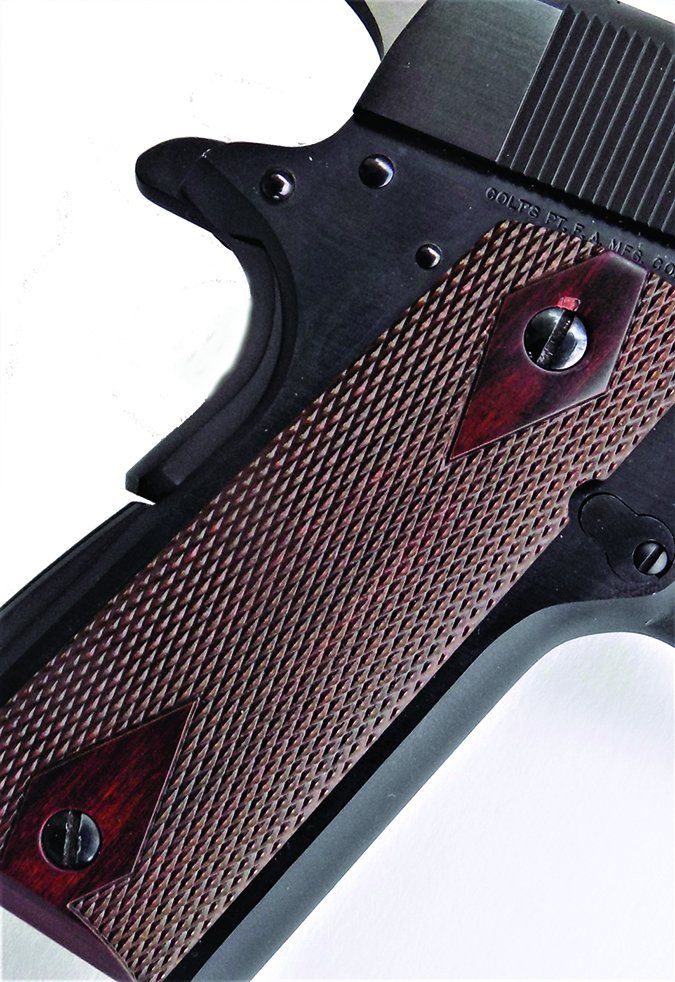
This pistol features a nice dark finish that is attractive. The appearance is good and the grips are nicely checkered. The pistol is supplied in a large cardboard box finished in Colt blue. Two magazines are supplied. Most of our raters liked the arched housing and short trigger. The fit of the slide lock safety, grip safety, slide lock and magazine release are good. This handgun isn’t designed for targets but for personal defense. Despite a similar appearance, the Series 70 and the bright polish handgun handled considerably different. The Series 70 frame and front strap was not slick like the high polish pistol, although it did not have the adhesion of the checkered front strap of the SIG or Les Baer handguns.

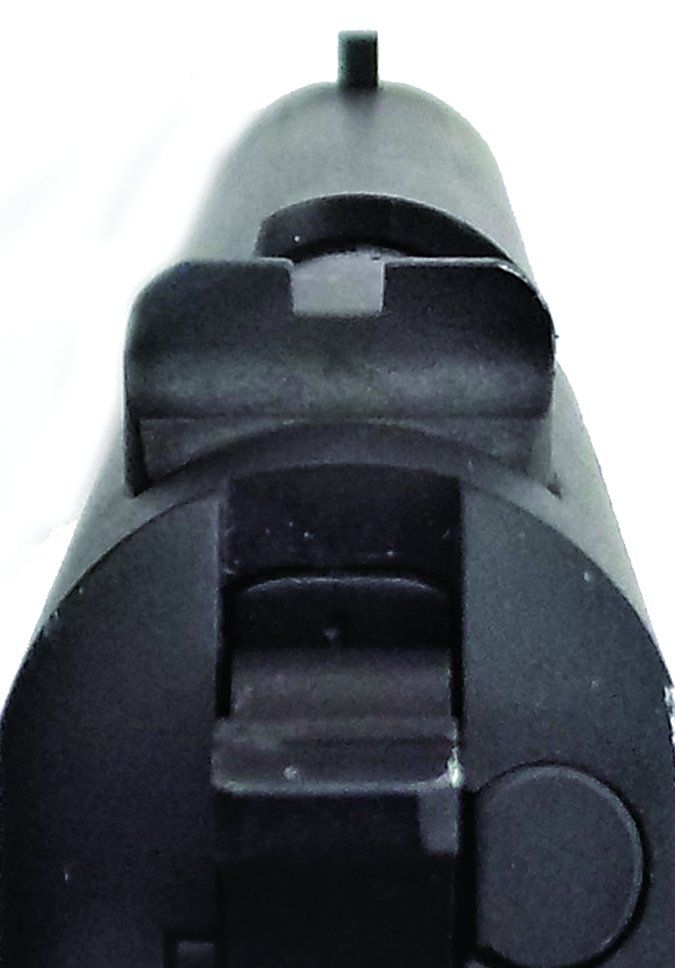
During the combat-firing stage, the Series 70 pistol cleared the holster quickly and came on target fast as well. This is the lightest 1911 tested, although it is a full-sized steel-frame handgun. There are no frills and no extraneous features. Trigger compression is 5.5 pounds and smooth. The short trigger makes the action feel lighter. The arched mainspring housing keeps the pistol settled in the hand. We had no problem consistently making center hits with the Series 70. Combat-shooting results were good without a single failure to feed, chamber, fire or eject. Still, the Les Baer and SIG pistols with their superior sights and gripping surfaces turned in better results. The Series 70 is an effective 1911 with good features. During the course of fire at 50 yards, firing at steel targets, the Series 70 turned in decent results, but again not in the class with the Les Baer and SIG. Fired for accuracy, the Series 70’s good fitting delivered good results. The best 25-yard group was a 1.8-inch cluster with the Hornady 200-grain XTP.
Our Team Said: The Series 70 is exactly what it is supposed to be: A no-frills back to the basics Colt. On that basis, there is nothing to fault. Reliability is spotless and practical accuracy acceptable. The price is right, too.
Colt Gold Cup National Match Blued O5870A1 45 ACP, $1190
GUN TESTS GRADE: A (Our Pick)
The National Match Colt is the most accurate of the five handguns tested, and looking at the best groups, it was superior by a considerable margin. Specific match-grade ammunition may give an even better showing. The pistol was reliable and easy to use well. There simply isn’t anything else to criticize.
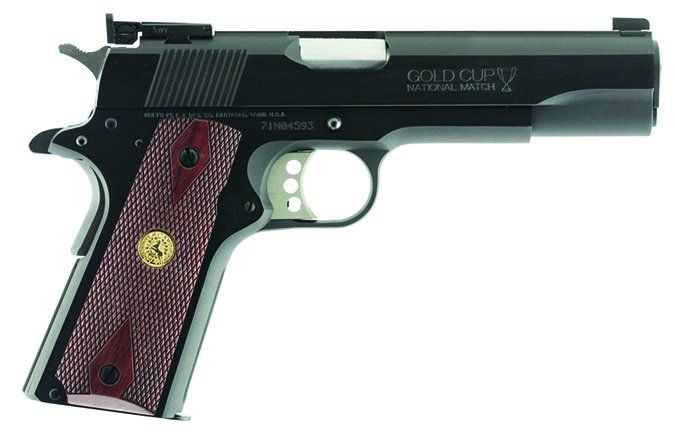
| ACTION | Single action only; locked breech, spur hammer |
| OVERALL LENGTH | 8.5 in. |
| OVERALL HEIGHT | 5.4 in. |
| OVERALL WIDTH | 1.3 in. |
| WEIGHT UNLOADED | 38 oz. |
| WEIGHT LOADED | 43 oz. |
| BARREL LENGTH | 5.0 in. long; match-grade stainless steel; 1:16 LH twist |
| MAGAZINE | (2) 8-round |
| SLIDE | Blued steel; Clark-style serrated rib; Full-length target recoil spring |
| SLIDE RETRACTION EFFORT | 15 lbs. |
| FRAME | Carbon steel, blued; beveled magazine well |
| FRAME FRONT STRAP HEIGHT | 2.8 in. |
| FRAME BACK STRAP HEIGHT | 3 in. |
| GRIPS | Checkered walnut; Colt medallion |
| GRIP THICKNESS (max) | 1.3 in. |
| GRIP CIRCUMFERENCE (max) | 5.5 in. |
| FRONT SIGHT | Steel post, dovetailed base |
| REAR SIGHT | Adjustable; Colt Champion Bomar-style |
| TRIGGER PULL WEIGHT | 4 lbs.; aluminum 3-hole; adjustable for overtravel |
| TRIGGER SPAN | 2.6 in. |
| SAFETY | Standard grip; standard thumb lever |
| WARRANTY | Lifetime |
| WEBSITE | Colt.com |
| TELEPHONE | (800) 962-COLT |
This was a recent price at BudsGunShop.com. The original Colt National Match was in most ways a development of the work done by Army gunsmiths to produce a credible competition firearm for Camp Perry. The original featured tightly fitted parts, including a barrel and barrel bushing that became known as National Match parts. The original was a robust gun with fixed sights. Later, adjustable sights were added. The pistol developed a reputation for fragility during the 1970s that wasn’t completely deserved; some of this reputation was due to misapplication of the gun to tasks it wasn’t designed for. A version with a lightened slide certainly wasn’t well suited to hardball loads. A sight held to the slide by a single roll pin sometimes flew loose during competition. We are covering this because you should know that a vintage Gold Cup National Match isn’t always the best choice as a shooter. With the introduction of the Series 80 pistols, certain improvements came along that made the pistol a superior piece for competition and even general use. Regulating spring weight can be a nightmare with a Gold Cup pistol that has had its springs replaced. You cannot judge spring weight by looking at the spring. The Gold Cup is supplied with a full-power recoil spring and a reduced-power spring for target loads. The lighter spring is painted green. The hammer spring is lighter as well. With the lighter hammer spring, the Gold Cup may function well with lighter target loads because it is easier for the slide to recoil and cock the hammer when the hammer spring is less than the standard 24 pounds. Keep this in mind and be certain you have the proper spring in place for the load. We conducted this test with the standard 16-pound recoil spring.
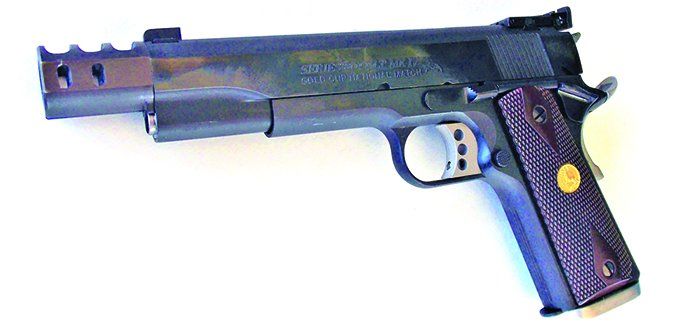
Colt lists this pistol as having a blued finish. At one time, the National Match pistols featured a Royal Blue finish similar to the Colt Python. We like the finish of this pistol, and it is excellent by any standard, but perhaps not the Royal Blue of 1960s. However, the frame and slide finish did not match. The slide features a post front sight and a close copy of the classic Bomar rear sight. The rear sight is adjustable for windage and elevation. This sight is a considerable improvement over Colt sights of the past. It is securely dovetailed in place in the manner we once paid custom gunsmiths to mount Bomar sights. The slide is smooth in operation as the slide rolls over the locking lugs. The trigger is an aluminum unit to prevent backlash from a heavy trigger. The factory trigger compression was a crisp 4.0 pounds out of the box.
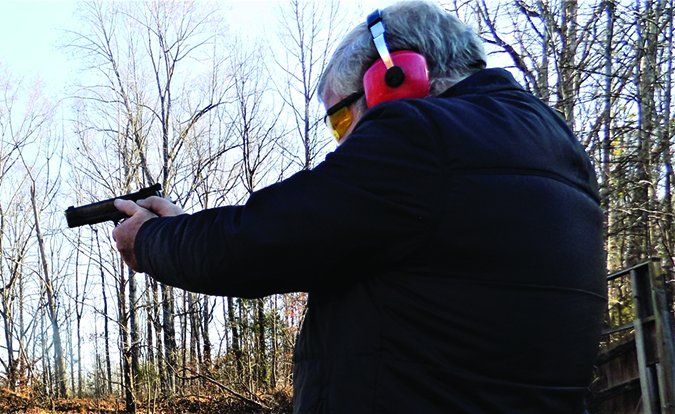
We also had access to a modified GCNM, whose owner added a stainless beavertail safety and a Wilson Combat barrel bushing with compensator ($79.95 from Wilsoncombat.com). These were viable accessories, and we tested their effect on recoil management during the combat course.
The grips are nicely checkered Colt wood grips with the rampant pony roundel. We like these grips better than the cheap plastic types found on Colt Gold Cups in recent years. The Gold Cup Trophy differs slightly from the National Match, and we prefer the National Match pistol for most uses. The National Match will be fitted with walnut grips. The frontstrap features striations for a firmer grip. For most uses, this is all that is needed to maintain a firm grip on the Colt. The Colt is supplied with two blue-steel Colt 8-round magazines. We took the slide off the pistol by removing the slide lock and running the whole unit forward. There were no tool marks of any type, and the internal finish was excellent.
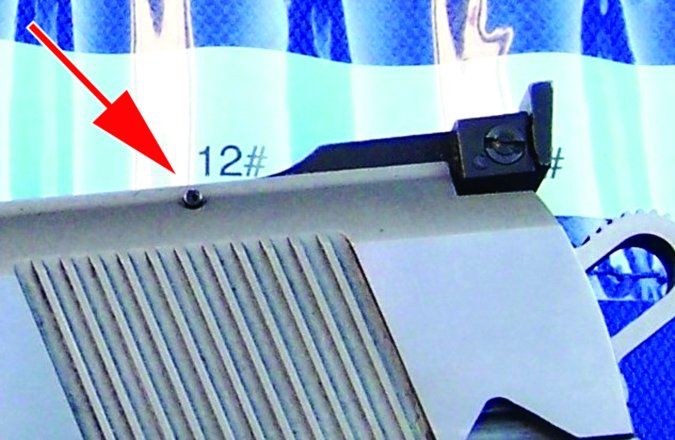
Running the combat course with the National Match at first seemed odd since our mind-set was “this is a target gun.” As it turned out, the Colt gave an excellent showing with all loads. With the Colt’s excellent trigger, our shooters did good work. There is no X-ring score in combat shooting, but the Colt did well. When it came to knocking over steel plates at 50 yards, the Colt turned in an excellent showing. There were no failures to feed, chamber, fire or eject. The Colt is a good shooter. We also found the Wilson Combat compensator definitely limited recoil. However, some shooters found the compensator distracting.
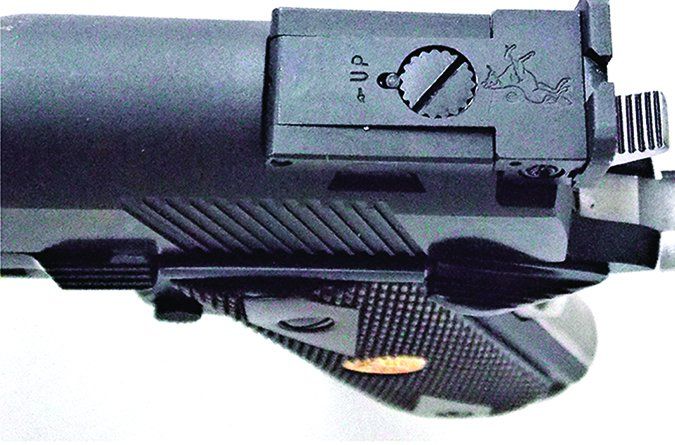
In bench accuracy, the National Match 45 gave excellent results. The best result at 25 yards was a 1.2-inch group. One rater remarked that he would like to work up handloads for this piece.
Our Team Said: The Colt National Match is a beautiful gun, well finished, and the most accurate handgun tested. The addition of the compensated barrel knocks it out as a carry gun, but for shooting action targets, it is worth a look.
To recap the other results of this grab-bag of 45s:

After firing more than 1600 cartridges during combat shooting and 225 more in the accuracy stage, we had a pile of brass and sore wrists. We learned the performance of the Les Baer was excellent by any standard. The pistol was ideal for most uses. The only drawback is the Concept VI’s expense. For working people and hobbyist, this expense may not be feasible. Just the same, we have much praise for the Concept VI.
The Colt Bright Stainless is an attractive handgun, but you really would have to want a pretty Colt to pony up for this one. The performance was, overall, at the bottom of the heap. It is reliable, but it is not the most impressive 45 on the combat course.
The Colt Series 70 was the least expensive gun tested. It would be the best carry gun for the money. It is lighter, fast into action, and doesn’t have adjustable sights to snag. Performance was excellent.
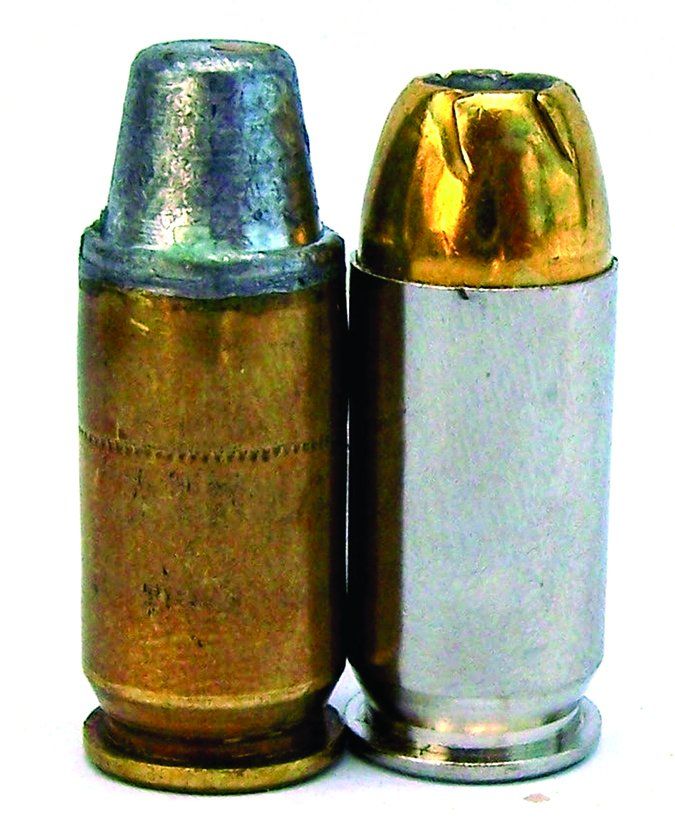
Grading the SIG Sauer 1911 is tricky, and you’ll have to adjust your expectations based on our results. As it came out of the box, the SIG is a D gun because of the malfunctions. If you were shooting only targets with it, those malfunctions wouldn’t be a threat to your health. The problems would simply make you a loser in a match. But when we looked at the overall package, we saw a lot to like. The pistol offers adjustable sights, which is a necessity for some types of shooting. The SIG wasn’t as tightly fitted as the Les Baer, but the former gave the Les Baer solid competition. Also, there’s room in the price to have a trigger job done to get it closer in performance to the Colt Gold Cup. The pistol was completely reliable with all loads after we changed the recoil spring, and this was a $6 upgrade, plus 10 minutes of disassembly. Thus, the dual grade of D/A-. If you’re willing to make the spring change, then consider the SIG to be a Best Buy.
Written and photographed by Gun Tests Staff, using evaluations from Gun Tests team testers.



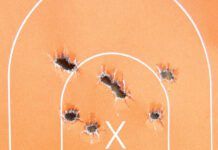














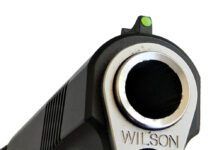

I think you were a little unfair to the Les Baers. You compared their carry gun to the Colt Goldcup, a target gun. I own the Les Baers carry and target and the Colt Goldcup. (Yes I have a 1911 problem). The grouping on the competition Les Baers in .9 inches at 50 yards using Federal Ball. (Yes I have the proofs and targets to prove it) I would suggest that the carry sights on the L’ Baers you compared to the target sights on the Colt put the two guns in slightly different classes.
Besides this criticism EXCELLENT Article.
In my personal opinion any gun or weapon is only good as the man or woman using it.